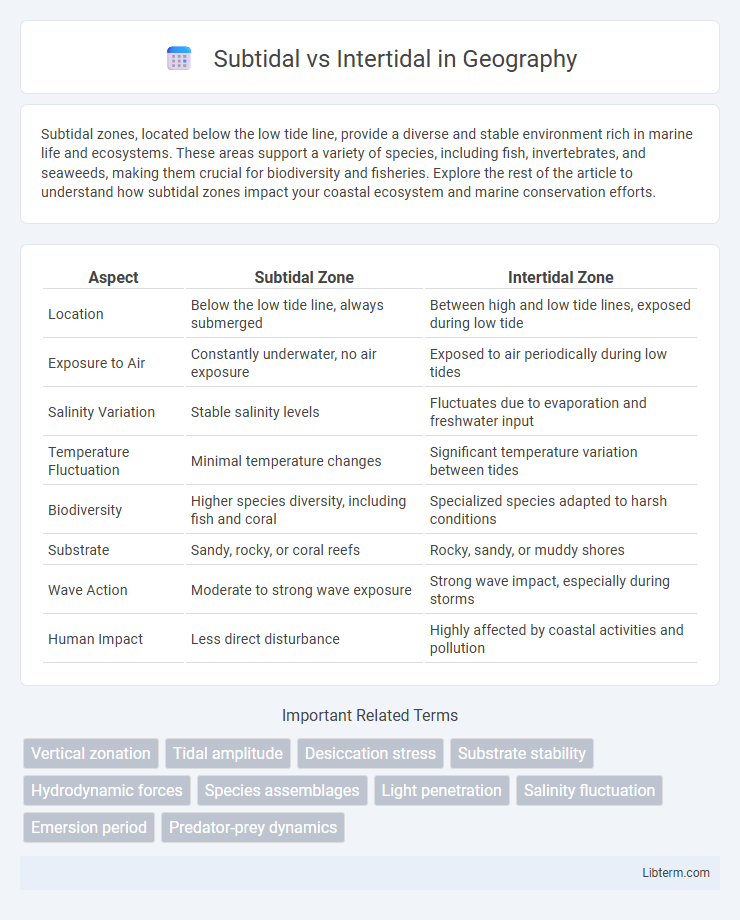Subtidal zones, located below the low tide line, provide a diverse and stable environment rich in marine life and ecosystems. These areas support a variety of species, including fish, invertebrates, and seaweeds, making them crucial for biodiversity and fisheries. Explore the rest of the article to understand how subtidal zones impact your coastal ecosystem and marine conservation efforts.
Table of Comparison
| Aspect | Subtidal Zone | Intertidal Zone |
|---|---|---|
| Location | Below the low tide line, always submerged | Between high and low tide lines, exposed during low tide |
| Exposure to Air | Constantly underwater, no air exposure | Exposed to air periodically during low tides |
| Salinity Variation | Stable salinity levels | Fluctuates due to evaporation and freshwater input |
| Temperature Fluctuation | Minimal temperature changes | Significant temperature variation between tides |
| Biodiversity | Higher species diversity, including fish and coral | Specialized species adapted to harsh conditions |
| Substrate | Sandy, rocky, or coral reefs | Rocky, sandy, or muddy shores |
| Wave Action | Moderate to strong wave exposure | Strong wave impact, especially during storms |
| Human Impact | Less direct disturbance | Highly affected by coastal activities and pollution |
Introduction to Subtidal and Intertidal Zones
Subtidal zones remain submerged below the low tide line, providing a stable habitat rich in marine life such as kelp forests and diverse fish species, while intertidal zones lie between the high and low tide marks, experiencing periodic exposure to air and fluctuating environmental conditions. Intertidal zones support specialized organisms like barnacles, sea stars, and mussels that adapt to drying and wave action, whereas subtidal zones offer consistently underwater environments favorable for coral reefs and seagrass beds. These distinct ecological zones influence species distribution, biological productivity, and coastal ecosystem dynamics.
Defining Subtidal and Intertidal Habitats
Subtidal habitats are marine zones that remain submerged below the low tide mark, supporting diverse ecosystems such as kelp forests and coral reefs due to constant underwater conditions. Intertidal habitats, located between the high and low tide lines, experience periodic exposure to air and water, hosting organisms adapted to fluctuating moisture, salinity, and temperature. These habitats play critical roles in coastal biodiversity, nutrient cycling, and serve as nurseries for various marine species.
Physical Characteristics and Environmental Conditions
Subtidal zones remain submerged beneath water regardless of tides, featuring stable temperature and salinity levels, while intertidal zones experience regular exposure to air, causing drastic fluctuations in temperature, salinity, and moisture. Subtidal areas typically showcase less wave action and more consistent light penetration compared to intertidal zones, which face intense wave impact and variable sunlight due to tidal changes. These physical distinctions lead to differing sediment types, with subtidal environments often having finer, more stable sediments and intertidal zones characterized by coarser, shifting substrates.
Biodiversity and Species Adaptations
Subtidal zones maintain constant submersion, supporting higher biodiversity with species adapted to stable conditions, including diverse fish, invertebrates, and algae thriving in nutrient-rich waters. Intertidal zones experience regular exposure and immersion, driving species to develop specialized adaptations like desiccation resistance, strong attachment mechanisms, and tolerance to temperature fluctuations. The dynamic intertidal environment fosters unique ecological niches, while subtidal habitats offer stable ecosystems promoting complex food webs and diverse marine life.
Ecological Roles and Ecosystem Functions
Subtidal zones maintain stable aquatic ecosystems supporting diverse marine life by providing continuous habitats for fish, invertebrates, and algae essential for nutrient cycling and food web stability. Intertidal zones experience fluctuating conditions due to tidal changes, fostering specialized organisms adapted to alternating wet and dry environments, which contribute to organic matter breakdown and serve as critical nursery grounds for juvenile species. Both zones play vital roles in sediment stabilization, water filtration, and maintaining biodiversity, underpinning coastal ecosystem resilience and productivity.
Human Impact and Environmental Threats
Subtidal zones face significant threats from pollution, overfishing, and habitat destruction due to human activities like coastal development and commercial fishing. Intertidal areas are vulnerable to oil spills, trampling by tourists, and climate change-induced sea-level rise, which disrupts delicate ecosystems. Both zones experience biodiversity loss and water quality degradation, highlighting the urgent need for conservation measures.
Methods for Studying Subtidal and Intertidal Zones
Research methods for studying subtidal zones often involve scuba diving, remote-operated vehicles (ROVs), and underwater cameras to monitor marine life and habitat conditions below the low tide mark. Intertidal zones are primarily studied through quadrat sampling, transect lines, and tidal pool observations during low tide periods to examine species diversity, abundance, and ecological interactions. Both zones benefit from environmental DNA (eDNA) sampling for detecting species presence and habitat health assessments.
Conservation Strategies and Management Approaches
Subtidal and intertidal zones require distinct conservation strategies due to their differing ecological dynamics and human impacts. Subtidal management emphasizes habitat protection through marine protected areas (MPAs), sustainable fishing regulations, and monitoring of water quality to preserve biodiversity and prevent overexploitation. Intertidal conservation prioritizes limiting coastal development, controlling pollution runoff, and implementing restoration projects like oyster reef rebuilding to maintain ecosystem resilience and support species reliant on tidal fluctuations.
Subtidal vs Intertidal: Key Differences
Subtidal zones remain submerged below low tide, supporting stable marine ecosystems with consistent water coverage, while intertidal zones experience periodic exposure during low tides, leading to fluctuating environmental conditions. Subtidal areas host diverse species adapted to constant aquatic environments, contrasting with intertidal organisms specialized in tolerating exposure, desiccation, and wave action. Key differences include water coverage stability, species adaptations, and environmental stressors unique to each marine zone.
Future Research and Emerging Trends
Future research on subtidal and intertidal zones emphasizes the impact of climate change on species distribution and ecosystem resilience, leveraging advanced remote sensing and AI-driven monitoring technologies. Emerging trends focus on understanding biogeochemical cycles and habitat connectivity to inform conservation strategies and sustainable resource management. Innovative methodologies, such as environmental DNA (eDNA) analysis, are enhancing species detection and biodiversity assessments in these dynamic marine environments.
Subtidal Infographic

 libterm.com
libterm.com